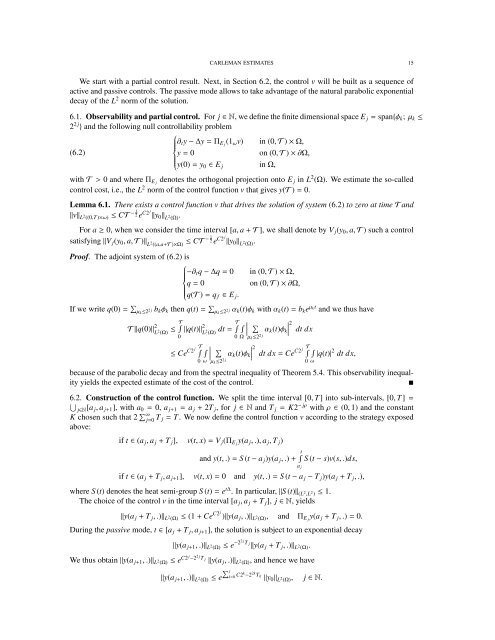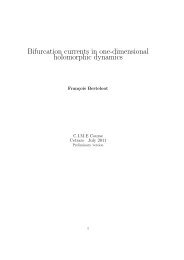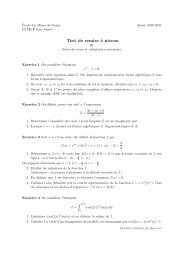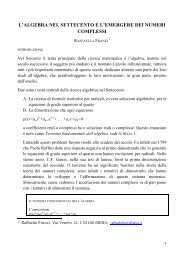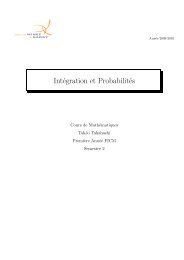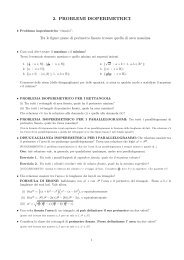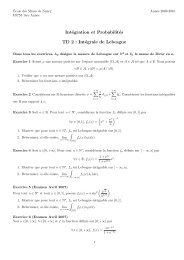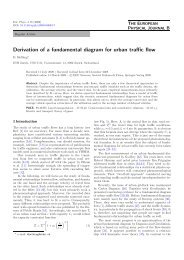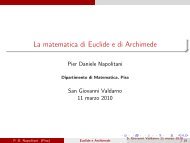on carleman estimates for elliptic and parabolic operators ...
on carleman estimates for elliptic and parabolic operators ...
on carleman estimates for elliptic and parabolic operators ...
You also want an ePaper? Increase the reach of your titles
YUMPU automatically turns print PDFs into web optimized ePapers that Google loves.
CARLEMAN ESTIMATES 15<br />
We start with a partial c<strong>on</strong>trol result. Next, in Secti<strong>on</strong> 6.2, the c<strong>on</strong>trol v will be built as a sequence of<br />
active <strong>and</strong> passive c<strong>on</strong>trols. The passive mode allows to take advantage of the natural <strong>parabolic</strong> exp<strong>on</strong>ential<br />
decay of the L 2 norm of the soluti<strong>on</strong>.<br />
6.1. Observability <strong>and</strong> partial c<strong>on</strong>trol. For j ∈ N, we define the finite dimensi<strong>on</strong>al space E j = span{φ k ; µ k ≤<br />
2 2 j } <strong>and</strong> the following null c<strong>on</strong>trollability problem<br />
⎧<br />
∂ t y − ∆y = Π E j<br />
(1 ω v) in (0, T ) × Ω,<br />
⎪⎨<br />
(6.2)<br />
y = 0<br />
<strong>on</strong> (0, T ) × ∂Ω,<br />
⎪⎩ y(0) = y 0 ∈ E j in Ω,<br />
with T > 0 <strong>and</strong> where Π E j<br />
denotes the orthog<strong>on</strong>al projecti<strong>on</strong> <strong>on</strong>to E j in L 2 (Ω). We estimate the so-called<br />
c<strong>on</strong>trol cost, i.e., the L 2 norm of the c<strong>on</strong>trol functi<strong>on</strong> v that gives y(T ) = 0.<br />
Lemma 6.1. There exists a c<strong>on</strong>trol functi<strong>on</strong> v that drives the soluti<strong>on</strong> of system (6.2) to zero at time T <strong>and</strong><br />
‖v‖ L 2 ((0,T)×ω) ≤ CT − 1 2 e C2 j ‖y 0 ‖ L 2 (Ω).<br />
For a ≥ 0, when we c<strong>on</strong>sider the time interval [a, a + T ], we shall denote by V j (y 0 , a, T ) such a c<strong>on</strong>trol<br />
satisfying ‖V j (y 0 , a, T )‖ L 2 ((a,a+T )×Ω) ≤ CT − 1 2 e C2 j ‖y 0 ‖ L 2 (Ω).<br />
Proof. The adjoint system of (6.2) is<br />
⎧<br />
−∂ t q − ∆q = 0 in (0, T ) × Ω,<br />
⎪⎨<br />
q = 0<br />
<strong>on</strong> (0, T ) × ∂Ω,<br />
⎪⎩ q(T ) = q f ∈ E j .<br />
If we write q(0) = ∑ µ k ≤2 b kφ 2 j k then q(t) = ∑ µ k ≤2 α k(t)φ 2 j k with α k (t) = b k e µ kt <strong>and</strong> we thus have<br />
T ‖q(0)‖ 2 L 2 (Ω) ≤ T ∫ ‖q(t)‖ 2 L 2 (Ω) dt = T ∫ ∫<br />
∑<br />
∣ ∣∣∣ 2<br />
∣ α k (t)φ k dt dx<br />
0<br />
0 Ω µ k ≤2 2 j<br />
≤ Ce C2 j T<br />
∫ ∫<br />
∑<br />
∣ ∣∣∣ 2<br />
∣ α k (t)φ k dt dx = Ce<br />
C2 j T<br />
∫ ∫ |q(t)| 2 dt dx,<br />
0 ω µ k ≤2 2 j 0 ω<br />
because of the <strong>parabolic</strong> decay <strong>and</strong> from the spectral inequality of Theorem 5.4. This observability inequality<br />
yields the expected estimate of the cost of the c<strong>on</strong>trol.<br />
<br />
6.2. C<strong>on</strong>structi<strong>on</strong> of the c<strong>on</strong>trol functi<strong>on</strong>. We split the time interval [0, T] into sub-intervals, [0, T] =<br />
⋃<br />
j∈N[a j , a j+1 ], with a 0 = 0, a j+1 = a j + 2T j , <strong>for</strong> j ∈ N <strong>and</strong> T j = K2 − jρ with ρ ∈ (0, 1) <strong>and</strong> the c<strong>on</strong>stant<br />
K chosen such that 2 ∑ ∞<br />
j=0 T j = T. We now define the c<strong>on</strong>trol functi<strong>on</strong> v according to the strategy exposed<br />
above:<br />
if t ∈ (a j , a j + T j ], v(t, x) = V j (Π E j<br />
y(a j , .), a j , T j )<br />
<strong>and</strong> y(t, .) = S (t − a j )y(a j , .) + t<br />
∫<br />
a j<br />
S (t − s)v(s, .)ds,<br />
if t ∈ (a j + T j , a j+1 ], v(t, x) = 0 <strong>and</strong> y(t, .) = S (t − a j − T j )y(a j + T j , .),<br />
where S (t) denotes the heat semi-group S (t) = e t∆ . In particular, ‖S (t)‖ (L 2 ,L 2 ) ≤ 1.<br />
The choice of the c<strong>on</strong>trol v in the time interval [a j , a j + T j ], j ∈ N, yields<br />
‖y(a j + T j , .)‖ L 2 (Ω) ≤ (1 + Ce C2 j )‖y(a j , .)‖ L 2 (Ω), <strong>and</strong> Π E j<br />
y(a j + T j , .) = 0.<br />
During the passive mode, t ∈ [a j + T j , a j+1 ], the soluti<strong>on</strong> is subject to an exp<strong>on</strong>ential decay<br />
‖y(a j+1 , .)‖ L 2 (Ω) ≤ e −22 j T j<br />
‖y(a j + T j , .)‖ L 2 (Ω).<br />
We thus obtain ‖y(a j+1 , .)‖ L 2 (Ω) ≤ e C2 j −2 2 j T j<br />
‖y(a j , .)‖ L 2 (Ω), <strong>and</strong> hence we have<br />
‖y(a j+1 , .)‖ L 2 (Ω) ≤ e∑ j<br />
k=0 C2k −2 2k T k<br />
‖y 0 ‖ L 2 (Ω), j ∈ N.


